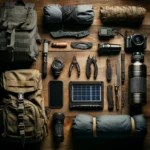Urban Prepping: Smart Solutions for Small Spaces
Introduction
There’s a common misconception that effective prepping requires sprawling storage spaces or a backyard shed brimming with supplies. However, for the city dwellers among us, the thought of fitting even just a few emergency supplies into a cramped apartment or small urban home can seem daunting. But fear not! Urban prepping is not only possible; it can be incredibly effective with the right strategies.
Understanding Urban Prepping
Urban prepping focuses on maximizing minimal space and prioritizing essentials that cater to the unique challenges of city living. The reality is that disasters and emergencies can strike anywhere, and being prepared is key—even in a high-rise apartment or a compact studio.
Space-Saving Strategies for Prepping
- Vertical Storage Solutions: Utilize vertical space for storage. Think over-the-door organizers, ceiling-mounted shelves, and stackable bins. Vertical storage not only helps save precious floor space but also keeps your supplies easily accessible.
- Multi-Purpose Items: Choose items that serve more than one purpose. For example, a flashlight that doubles as a radio and a charger can save space and add value. Furniture with built-in storage, like ottomans or beds with drawers, can also be perfect for stashing away supplies discreetly.
- Compact and Collapsible Items: Opt for gear that can be compacted or collapsed when not in use, such as foldable water containers, collapsible cooking gear, and inflatable solar lanterns. These items take up less space and can be expanded or utilized when needed.
Essential Supplies for Urban Preppers
- Water Purification: In an urban environment, storing large quantities of water can be unrealistic. Instead, focus on water purification methods like filtration straws or bottles, and chemical purifiers that can make urban water sources safe to drink.
- Food Storage: Invest in high-calorie, non-perishable food items that require minimal preparation and space. Think energy bars, dried fruits, and ready-to-eat meals. Using vacuum-sealed bags can further reduce their storage space.
- First Aid and Hygiene: Keep a well-stocked first aid kit tailored to potential urban hazards. Also, include hygiene supplies like hand sanitizers and wet wipes that can be crucial when water is scarce.
Practical Tips for Urban Emergency Preparedness
- Stay Informed: Have a battery-powered or hand-crank radio to stay updated with the latest emergency information.
- Emergency Plan: Develop an evacuation plan that considers the unique aspects of urban environments, such as high traffic and limited exit routes. Practice this plan periodically.
- Community Resources: Familiarize yourself with local resources like emergency shelters and food banks. In times of crisis, knowing where to go can save crucial time.
Conclusion
Living in a smaller urban space doesn’t mean sacrificing your preparedness. With smart storage solutions and a focus on essential supplies, urban dwellers can create a comprehensive prep plan that makes the most out of limited space. Remember, the goal of urban prepping is not just to survive but to thrive during emergencies by making smart, space-efficient choices.
Call to Action
Start small and think creatively. Even the smallest effort towards preparedness can significantly boost your resilience in emergencies. Explore more tips and tricks on urban prepping at Vitaclicks.com, where we help you stay prepared, no matter the size of your living space!
By adopting these practical tips and strategies, you’ll find that you can effectively prepare for any situation, all while navigating the unique challenges of urban living.




